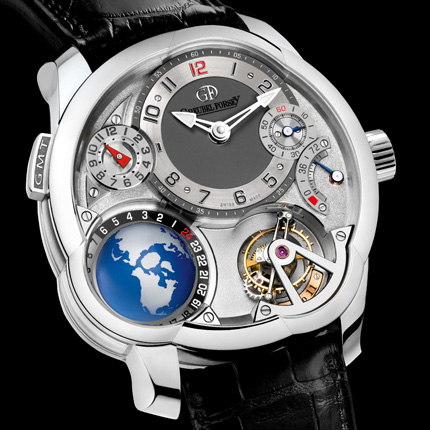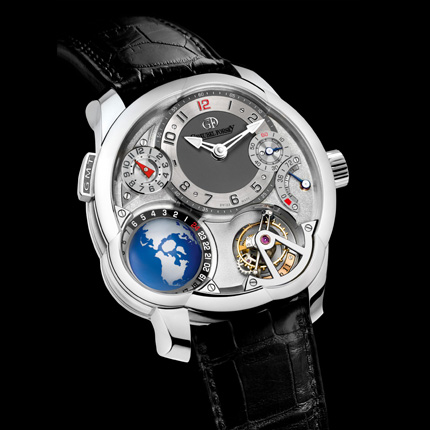
Asymétrique
Power reserve: 72 h, 21600 vph
From the Tourbillon to World time: Greubel Forsey presents the GMT
This timepiece marks a first for both Greubel Forsey and the history of GMT watches. After exploring, inventing, and developing new mechanisms in the world of the tourbillon over the last decade, Robert Greubel and Stephen Forsey have now combined it with a new complication, the GMT, which they have naturally interpreted in their own way.
With this remarkable timepiece, Robert Greubel and Stephen Forsey have focused their energy on indicating a second time zone, a complication traditionally denoted by GMT (Greenwich Mean Time), the historical reference meridian for navigators.
A highly-practical complication and one greatly-valued by connoisseurs, a second time zone is of particular benefit for globetrotting businessmen, frequent leisure travellers and those with family and friends around the world. True to their philosophy and continuous quest for perfection and innovation, Greubel Forsey have gone way beyond the conventional means of displaying a second time zone.
The GMT features a wonderful, three-dimensional temporal representation: A rotating terrestrial globe offering a truly original view of time all over the world. This technical yet poetic marvel provides us with a completely new way of perceiving the different time zones.
Nestled in a prominent position at 8 o'clock, the ‘flying' globe is ingeniously secured at just one end of its rotational axis – the South Pole – allowing for optimal views of the intricate surface that has been crafted on the strong, yet lightweight, titanium sphere.
While the globe makes one complete rotation every 24 hours anticlockwise – the Earth's natural rotational direction – the position of the continents can be neatly cross-referenced with the 24-hour, day-and-night indicator on the equatorial chapter ring. The night-time hemisphere – 18:00 to 6:00 – is indicated by a blackened half of the ring around the globe, while the daytime hemisphere – 6:00 to 18:00 – is indicated by a whitened portion. The latter is superbly enhanced by a lateral window cleverly integrated into the caseband, which lets in light to symbolise daytime on the globe, and reveals more of the southern hemisphere.
So if it is midday in England, the viewer can see at a glance that it is the beginning of the afternoon in Geneva or Rome, that the sun is only just rising on the East Coast of the United States and that the darkness of night has fallen over the Far East. Just one quick glance is enough to know the time anywhere in the world – a longer look and it will be for the sheer aesthetic pleasure of viewing the delightful details on the intricately crafted globe.
The intuitively interpreted globe is complemented at 10 o'clock by the 12-hour second time zone dial giving a precise indication of the time in a designated second country or city and is easily adjusted using the quick-set, dual-function pusher on the caseband at 10 o'clock.


